
* In the 21st century Brazil, has become an emerging technological power, with one of the contributors to this movement being the Embraer aerospace company. Embraer is an international success story, with one of its most prominent products being the "EMB-312 Tucano" tandem-seat turboprop trainer and light attack aircraft, in service with many air arms around the world. The Tucano has been followed by the more capable "Super Tucano". This document provides a history and description of the Tucano and Super Tucano. A list of illustration credits is provided at the end.
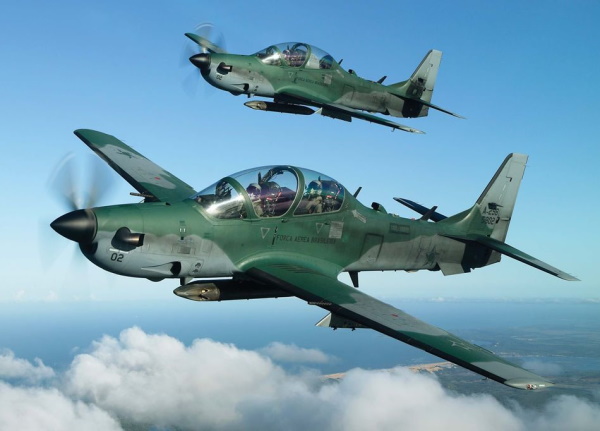
* Up into the early 1960s, the Forca Aerea Brazileira (FAB / Brazilian Air Force) used the classic North American T-6 Texan as the service's primary flight trainer, with the aircraft built under license in Brazil by Lagoa Santa. In 1965, the Brazilian Ministerio da Aeronautica (MdA / Air Ministry) commissioned studies with the Centro Tecnico Aerospacial (CTA / Central Aerospace Technical Organization) to develop a turboprop-engined Texan. Although this work went as far as wind tunnel tests, the notion of a turboprop-powered trainer was abandoned for the time being, with the Sociedade Neiva of Sao Jose dos Campos, Sao Paulo, commissioned to develop an entirely new side-by-side piston-powered trainer.
The "Neiva T-25 Universal", as the aircraft was named, performed its initial flight on 29 April 1966. It was a neat, conventional small piston aircraft, with tricycle landing gear. One prototype and 146 production machines were built -- some sources give more -- and at last notice the type remains in service as the FAB's primary trainer. The Sociedad Neiva proposed a number of turboprop-powered derivatives of the T-25, but none ever flew.
Although the CTA's work on the "Turbo Texan" didn't pan out, the organization also conducted design studies on a twin-engine turboprop transport, with the initial prototype of what was then known as the "YC-95" performing its initial flight in 1968. The next year, 1969, the CTA and several other Brazilian aeronautical organizations were folded into a new state-run firm, the Empresa Brasileira de Aeronautica (EMBRAER), also at Sao Jose dos Campos. EMBRAER put the YC-95 into production as the very successful "EMB-110 Bandeirante". Incidentally, the company eventually de-emphasized the acronym EMBRAER, and is now know as "Embraer" -- which is used below for simplicity.
* By the mid-1970s, the FAB was again casting about for a new trainer. At the time, Brazil was under a military government and as a result the country was under arms embargoes. That made a locally-developed solution attractive, and in the spring of 1977 the MdA issued a requirement for a training and light strike aircraft. Embraer came up with two proposals, including the piston-powered "EMB-301" trainer and light strike aircraft, and the turboprop-powered "EMB-311" light attack aircraft. Sociedad Neiva also proposed a "YT-25B Universal II" trainer and light attack aircraft based on the Universal I; the firm built a flight prototype.
These designs were not what the FAB was thinking about, and so in the summer of 1977 the MdA issued another requirement, this time for a turboprop trainer and light attack aircraft. Embraer updated the EMB-311 into a trainer / light attack aircraft designated the "EMB-312"; it still wasn't quite what was wanted, but it seemed on the right track, so in early 1978 Embraer engineers reworked the design further to conform to FAB desires. In September 1978 Embraer was authorized to begin full development, with work on four prototypes -- two flight prototypes and two static-test prototypes -- beginning in 1979.
Initial flight of the first EMB-312 prototype was on 16 August 1980, with retired FAB Colonel Luiz Fernando Cabral at the controls and engineer Gilberto Hideo Otaka in the back seat. Trials went well, with the type being given the name "Tucano" in October 1981; the pure trainer version was the "T-27", while the trainer / light attack variant was the "A-27".
One of the prototypes was lost in an accident on 10 August 1982, but a third flight prototype had been authorized and built by that time, with this machine performing its first flight six days later. The FAB had already placed an initial production order, with the first production machine being delivered on 29 September 1983. 133 were obtained by the FAB, with the Tucano becoming the mount for the FAB's aerobatic display team, the Esquadrao de Demonstracio Aerea (EDA).
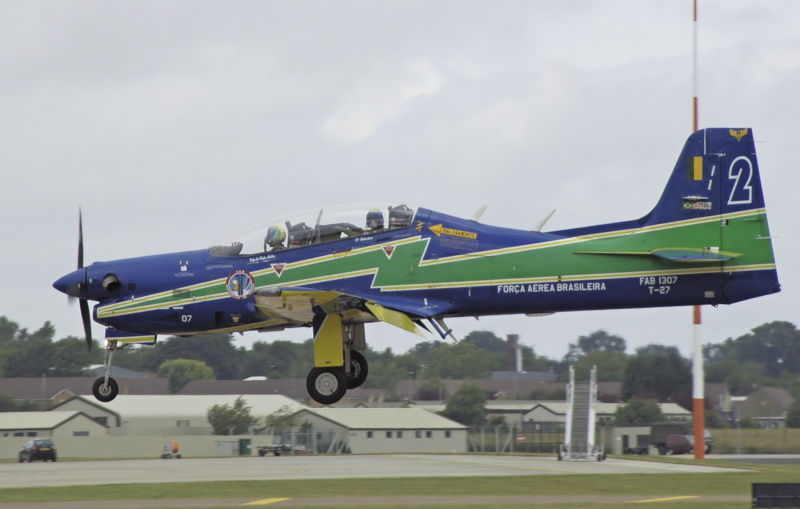
From the 1990s, the Brazilian government began to enhance on improving security in the wild backwoods regions of the Amazon basin, where drug traffickers and the like had long operated with impunity. The result was the formal establishment, in 1997, of the "SIstema de Vigilancia da AMazonia (SIVAM)" as a collaborative exercise between the FAB and other Brazilian government organizations. Tucanos were put to work under SIVAM as "gunfighters", carrying out air attacks on illegal settlements in the jungle and intercepting suspicious aircraft that might be carrying drugs.
BACK_TO_TOP* As it emerged, the Tucano was a low-wing aircraft of all-metal construction, with retractable tricycle landing gear. It was powered by a Pratt & Whitney Canada (PWC) PT6A-25C turboprop providing 560 kW (750 SHP), driving a Hartzell three-bladed variable-pitch constant-speed propeller. There were two fuel tanks in each wing, providing four tanks with a total fuel capacity of 660 liters (174 US gallons). The aircraft was fully aerobatic.
All flight surfaces were unswept, but with tapered planforms. Flight control layout was conventional, with a one-piece slotted flap inboard on each wing plus an aileron outboard, with rudder and elevators on the tail assembly. Primary flight controls were manual, except for electrically actuated flaps. Trim tabs were fitted, as was a tailfin fillet extension, presumably to compensate for the Tucano's long and high canopy. All landing gear had single wheels and were hydraulically retractable, with the steerable nose gear retracting backwards, while the main gear hinged from the wings to retract towards the fuselage.
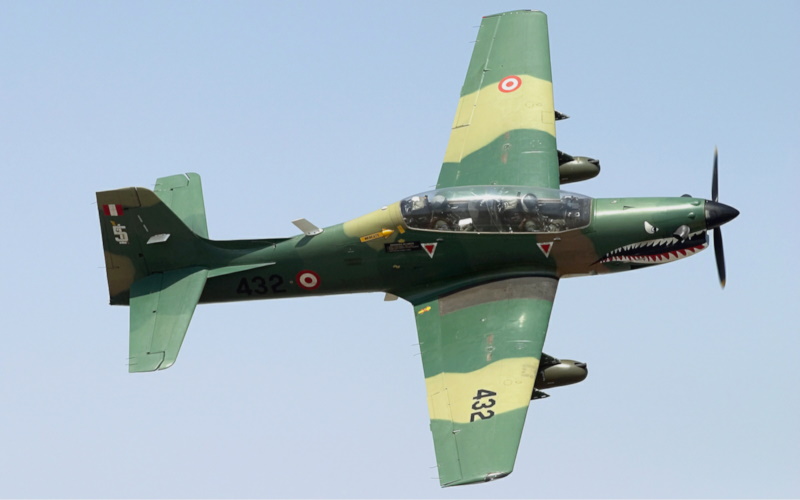
The crew sat in tandem on Martin-Baker BR8LC zero-zero (zero altitude, zero speed) ejection seats, under a jettisonable single-piece canopy that hinged open to the right. The cockpit was pressurized and climate-conditioned. Dual controls were standard. Two stores pylons could be fitted under each wing for a total of four, with typical stores being machine-gun pods, unguided rocket pods, or unguided bombs, to a total stores load of 1 tonne (2,200 pounds). A reflex gunsight was fitted in the cockpit for weapons aiming. The inboard stores pylons were "wet", permitting carriage of a total of two ferry tanks, providing 330 liters (87 US gallons) capacity each.
___________________________________________________________________
EMBRAER EMB-312 TUCANO:
___________________________________________________________________
wingspan:
11.14 meters (36 feet 6 inches)
wing area:
19.4 sq_meters (209 sq_feet)
length:
9.86 meters (32 feet 4 inches)
height:
3.4 meters (11 feet 2 inches)
empty weight:
1,810 kilograms (3,990 pounds)
MTO weight:
3,175 kilograms (7,000 pounds)
max speed at altitude:
450 KPH (275 MPH / 240 KT)
take-off run:
380 meters (1,250 feet)
landing run:
370 meters (1,215 feet)
service ceiling:
9,150 meters (30,000 feet)
range, internal fuel:
1,845 kilometers (1,145 MI / 995 NMI)
___________________________________________________________________
* The Tucano proved popular in the export market, particularly with other Latin American countries:
* In the early 1980s, the British Royal Air Force (RAF) was after a replacement for the aging Hunting Jet Provost trainer. A number of firms competed for the contract, with Embraer teaming up with Shorts of the UK to offer a Tucano derivative. The Tucano won the competition in May 1985.
Shorts was to perform license construction at a plant in Belfast, Northern Ireland. The RAF Tucanos were enhanced as per contract specification, being fitted with new avionics, a modified canopy, a hydraulically-actuated ventral airbrake, and in particular a more powerful engine -- the Garrett TPE331-12B turboprop, providing 820 kW (1,100 SHP) and driving a four-blade propeller. A standard Tucano was fitted with the Garrett engine as a demonstrator, performing its first flight on 11 April 1986.
The first Shorts-built "Tucano Trainer Mark 1 (T.1)" performed its initial flight on 30 December 1986, with the first machine for evaluation delivered on 26 June 1987. Initial service delivery to the RAF was on 16 June 1988, with 131 Tucano T.1s being delivered up to final delivery in early 1993. They are used for primary training and apparently rarely, if ever, carry armament. The RAF is planning to replace them with the Raytheon T-6C Texan II.
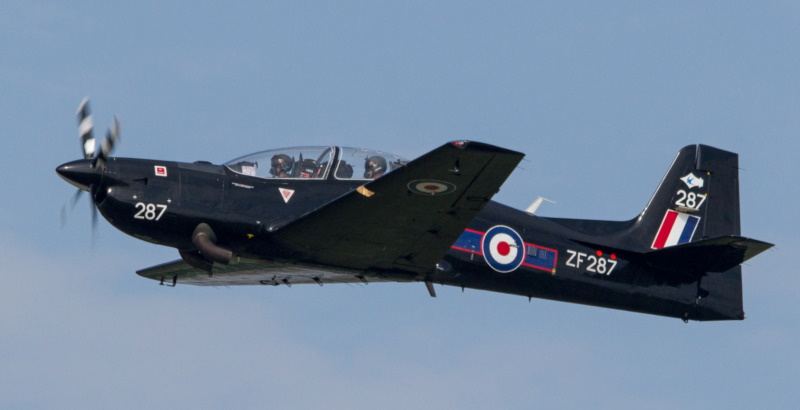
Somewhat surprisingly, the terms of the deal between Embraer and Shorts allowed Shorts to sell Tucanos on the export market -- Embraer officials, it seems, felt that being handed the royalties was good enough. Twelve Shorts Tucano "T.51s" were sold to Kenya in 1988, replacing the BAC Strikemaster, being delivered in 1990; 16 "T.52s" were sold to Kuwait in 1989, though due to the first Gulf War, they weren't delivered until 1995. Both the T.51 and T.52 were combat-capable, though they were employed as trainers.
* Embraer also developed a specialized variant of the Tucano for the Armee de l'Aire, the French Air Force, with the French buying what would end up being 49 machines in 1991 as replacements for the Fouga Magister jet trainer. These aircraft were designated "EMB-312F" and had various changes from Tucano standard, including a dashboard with LCD displays, ventral airbrake, de-icing gear, and structural reinforcements. They retained the PT6A powerplant. Deliveries were from 1993 to 1997.
Valkyrie Aero, of Mesa AZ, obtained a dozen ex-French Tucanos and 20 ex-RAF Shorts Tucanos -- configured as A-27s for the attack mission, with an imaging / targeting turret -- for the "tactical training for hire" mission.
BACK_TO_TOP* In 1988, Embraer and the FAB began to consider a more powerful and combat-oriented derivative of the Tucano for counterinsurgency and anti-smuggling operations. The concept was named the "Super Tucano" and was initially assigned the designation of "EMB-312H". (There was consideration at the outset of designating it the "EMB-312F" for "Future Tucano", but the French variant of the Tucano was assigned that code instead.)
A demonstrator was built by modifying a stock Tucano with a more powerful PWC PT6A-67 turboprop engine providing 935 kW (1,250 SHP); stretching the rear fuselage by 1.31 meters (4 feet 4 inches); and fitting a ventral airbrake. Initial flight of the Super Tucano demonstrator was on 9 September 1991, with test pilot G. Predrosa Schittini at the controls. Two full prototypes were then built, the first flying on 15 May 1993 and the second on 14 October 1993. The prototypes featured a new cockpit layout and canopy, as well as a still-more-powerful PT6A-68A turboprop engine with 970 kW (1,300 SHP).
In 1994, the Brazilian government divested itself of Embraer, converting the organization into a private company, and in principle exposing it to the full force of market competition. Embraer energetically promoted the Super Tucano. The two prototypes were evaluated by the US military for the "Joint Primary Aircraft Training System (JPATS)", but though the Super Tucano got good reviews, the Raytheon-Pilatus Texan 2 -- a modified Pilatus PC-9 -- won the contract. The FAB remained interested, considering the Super Tucano as an "enforcer" for SIVAM and possibly for advanced flight training. In August 1995, Embraer was awarded a contract for the "ALX (Aeronave Leve de Ataque / Light Attack Aircraft)", a derivative of the EMB-312H.
The FAB specified a list of improvements, including a full glass cockpit with twin LCD multifunction displays (MFDs), a head-up display (HUD), "hands on throttle and stick (HOTAS)" controls, and night vision goggle (NVG) compatibility; updated avionics, including a new stores management system; a "wet" centerline stores pylon in addition to the four wing pylons; compatibility the Brazilian Mectron MAA-1 Piranha AAM, a Sidewinder look-alike; and twin fixed ventral fins.
The two EMB-312H machines were updated to this configuration as ALX prototypes. Further changes were specified and implemented, most significantly a reprofiled wing; a 12.7 millimeter machine gun with 200 rounds in each wing; a still further uprated PWC PT6A-68/3 engine with 1,195 kW (1,600 SHP), driving a five-bladed Hartzell propeller; a new canopy; and reinforced landing gear to handle greater take-off weights with a heavier stores load, now up to 1,500 kilograms (3,300 pounds). The first of the two prototypes to receive the definitive set of modifications performed its first flight in its new configuration on 2 June 1999, with retired FAB Colonel Marcos Salgado de Olivera at the controls. The changes had been so considerable that the type was given a new code, the "EMB-314 Super Tucano".
The FAB wanted both a single-seat configuration, with the military designation of "A-29A", and a two-seater dual-control configuration, the "A-29B". The primary difference was that the single-seater was to have an additional fuel tank replacing the rear seat of the two-seater. The first prototype to be brought up to full spec was to single-seater configuration, with the second prototype brought up to two-seater configuration and performing its first flight on 22 October 1999.
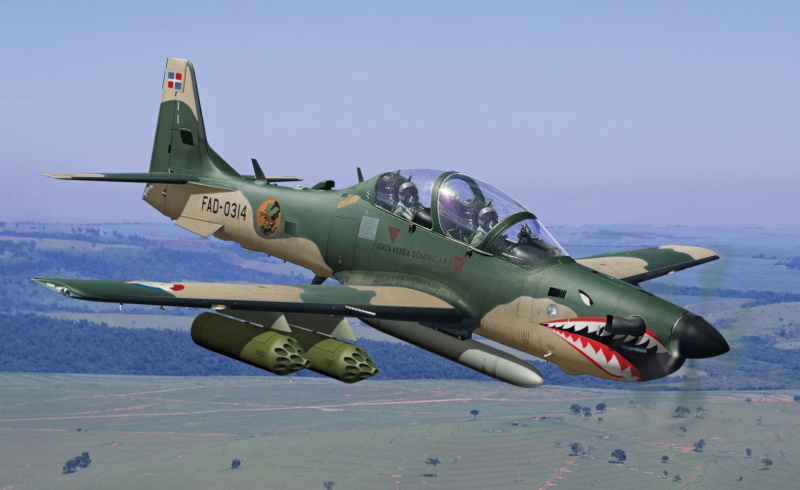
The definitive aircraft featured Martin-Baker Mark 10 LCX zero-zero ejection seats. The design had accommodations for a forward-looking infrared (FLIR) imager turret and a defensive countermeasures system, but it is unclear from sources whether the FAB wanted these features implemented from the outset.
___________________________________________________________________
EMBRAER EMB-314 SUPER TUCANO:
___________________________________________________________________
wingspan:
11.14 meters (36 feet 6 inches)
wing area:
19.4 sq_meters (209 sq_feet)
length:
11.42 meters (37 feet 6 inches)
height:
3.9 meters (12 feet 10 inches)
empty weight:
2,420 kilograms (5,335 pounds)
MTO weight:
3,190 kilograms (7,035 pounds)
max speed at altitude:
555 KPH (345 MPH / 300 KT)
take-off run:
350 meters (1,150 feet)
landing run:
550 meters (1,805 feet)
service ceiling:
10,670 meters (35,000 feet)
range, internal fuel:
1,570 kilometers (975 MI / 850 NMI)
___________________________________________________________________
There were some political hangups in obtaining a production order, but a contract for 25 A-29A single-seaters and 51 A-29B two-seaters was signed in the summer of 2001. The first production machine went into test and evaluation in October 2003, with the Super Tucano finally going into FAB service in August 2004. The last of the FAB order of 99 aircraft was delivered in 2012.
Export sales followed introduction to service with the FAB, with buyers including:
Venezuela wanted to buy a batch of Super Tucanos, but Venezuela and the US were not getting along well, and the Americans were not inclined to approve the use of components of US origin in the export aircraft. Embraer considered replacing those components with French kit, but at last notice it hadn't happened.
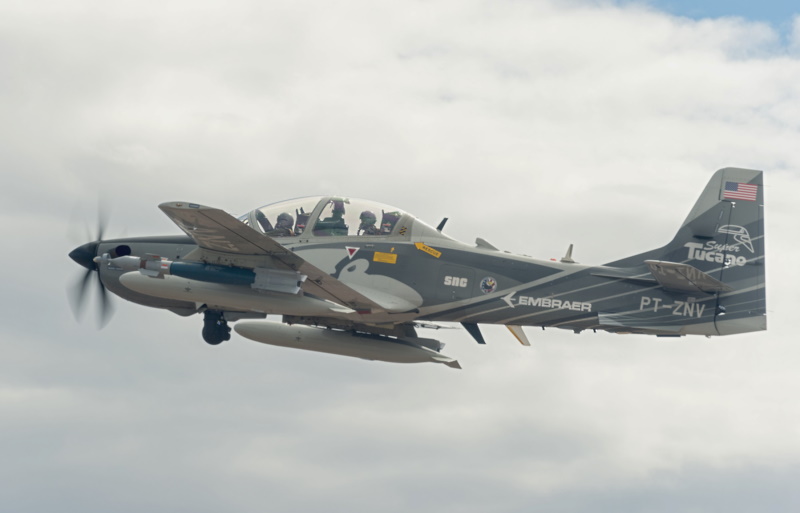
One was obtained by US security firm Blackwater in 2008 for training, this unarmed machine then being sold off to an outfit named Tactical Air, which provides aerial support services for the US military, and brought up to armed spec. This aircraft was demonstrated to both the US Navy and Air Force with an eye towards use in the counter-insurgency role, the effort leading to the Super Tucanos obtained by Afghanistan.
The US was interested in obtaining a light-attack capability for a time and obtained at least two Super Tucanos for evaluation. However, the effort fell off the priority queue, with the end result of the US obtaining light attackers like the Super Tucano for US allies.
BACK_TO_TOP* Other countries are offering turbo trainers to compete for deals, including the Polish "PZL-130 Orlik (Spotted Eaglet)" and South Korean KAI "KT-1 Woongbee (Great Flight)".
The Orlik began life in the early 1980s as a tandem-seat primary trainer, powered by the Soviet-built Vedeneyev M-14Pm radial engine, with 245 kW (330 HP). Three prototypes were planned, with the first flying on 12 October 1983. However, during the 1980s, the USSR was becoming increasingly creaky and obtaining engines was problematic; the other two prototypes and two preproduction machines were built, but the situation was so difficult that PZL turned to use of the Polish-made Kalisz K8-AA radial engine, building a sixth aircraft with that engine fit. The K8-AA had less horsepower than the M-14Pm, making the aircraft underpowered, and by 1990 work on a piston-powered version of the Orlik had been abandoned.
That was because work on a turboprop version was much more promising. In 1984, PZL engineers had begun investigation of a turboprop Orlik, with the third Orlik prototype re-engined with a PT6A-25 and performing its initial flight on 13 July 1986. This machine was lost in a crash in January 1987, but a seventh was built with the Polish Walter M601E turboprop, with 560 kw (750 SHP). Four more "Turbo Orliks" with PT6A or Walter engines were built, being designated "PZL-130TM" and "PZL-130T".
The Polish Air Force ordered a batch of nine "PZL-130TB" machines, basically improved versions of the PZL-130TM with the Walter M601T turboprop and East European avionics. The PZL-130TB was followed by the "PZL-130TC-1", with improved avionics and Martin-Baker PL11B zero-zero ejection seats; 15 new-build aircraft and 8 upgrades were obtained by the Polish Air Force. The PZL-130 TC-1 has a span of 9 meters (29 feet 6 inches), a length of 9 meters (29 feet 6 inches), an empty weight of 1,600 kilograms (3,525 pounds), and a top level speed of 455 KPH (280 MPH / 245 KT).
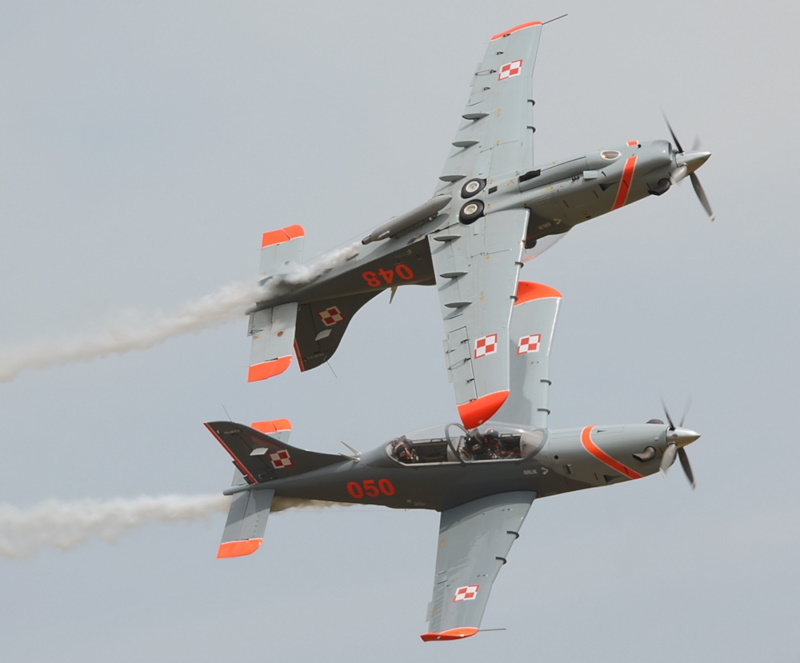
Development went on in parallel on a "PZL-130TC" with a PT6A-62 turboprop and Westernized avionics. The prototype performed its initial flight on 9 July 1994, but was lost in an accident in 1996. PZL later became part of the multinational Airbus Group, and from 2014 has been promoting an Orlik "Multi-Purpose Trainer (MPT)", based on the updated "Orlik TC II", featuring a new wing, a glass cockpit, and other minor updates, with flight demonstrations to customers from 2014. An armed attack variant has been considered. Orliks in Polish service are being updated to the "TC II Advanced" standard.
* The KT-1 Woongbee began life in 1988, with the formation of Korea Aerospace Industries (KAI), an industry group with Daewoo as the major player. The "KTX-1 (Korean Trainer Experimental 1)" was intended to replace Cessna T-37s and T-41s in the Republic Of Korea Air Force (ROKAF), and was to be the first modern aircraft designed and built in South Korea. Four flight and three static-test machines were ordered, with the first flight prototype taking to the air on 12 December 1991. Further work led to the flight of a preproduction prototype to nominal service spec in March 1998. Initial deliveries of a batch of 85 KT-1 production machines for the ROKAF began in 2000.
As introduced, the KT-1 had the same general configuration as the Tucano or PC-9 -- being occasionally judged to be a license-built version of the PC-9, but it was a new design. It was powered by a PWC PT6A-62A turboprop with 710 kW (950 SHP), driving a four-bladed Hartzell propeller, and has a digital glass cockpit. It had a span of 10.6 meters (34 feet 9 inches), a length of 10.26 meters (33 feet 8 inches), an empty weight of 1,790 kilograms (3,945 pounds), and a max level speed of 650 KPH (405 MPH / 350 KT).
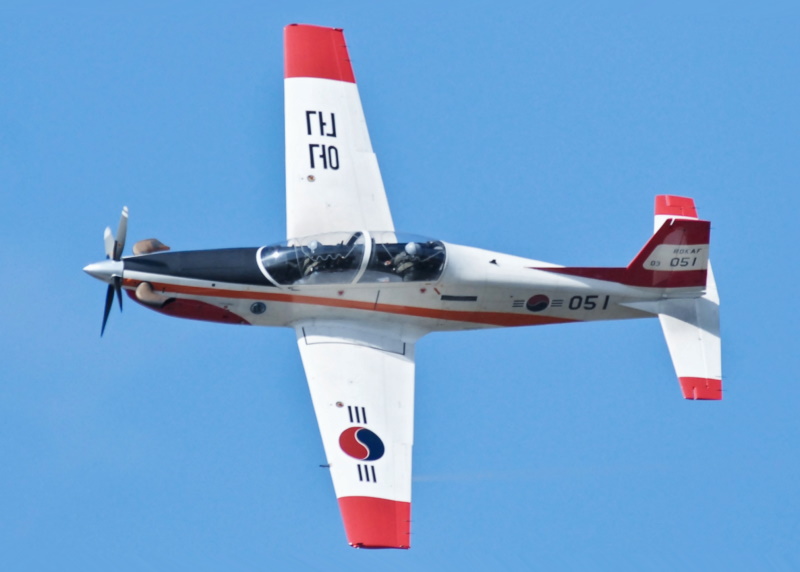
KAI developed an armed battlefield spotter version of the KT-1, the "KO-1", and apparently a number of KO-1s were obtained by the ROKAF. An export version, the "KT-1B", was sold to Indonesia, with seven delivered in 2003 and five more delivered in 2005. A further improved export version, the "KT-1C", is being promoted on the export market; Senegal ordered four in 2016. KAI also signed a deal for 40 "KT-1T" trainers for Turkey in 2007, with an option for 15 more that was exercised in 2015.
* The Turkish KT-1Ts were obtained as a stopgap; Turkish Aerospace Industries went on to develop a trainer based on the KT-1, the "Huerkus" -- named after Vecichi Huerkus, Turkey's first pilot -- tailored to Turkish Air Force requirements. Three variants are planned: A low-end "Huerkus A" for civilian use, a "Huerkus B" with more advanced cockpit avionics for military use, and an attack-optimized "Huerkus C". The Huerkus C will have armor, defensive countermeasures, an NVG-compatible cockpit, an imaging / targeting turret, and five stores pylons. Initial flight of the Huerkus A was in August 2013, with certification in 2016, and initial deliveries to the Turkish Air Force in 2017.
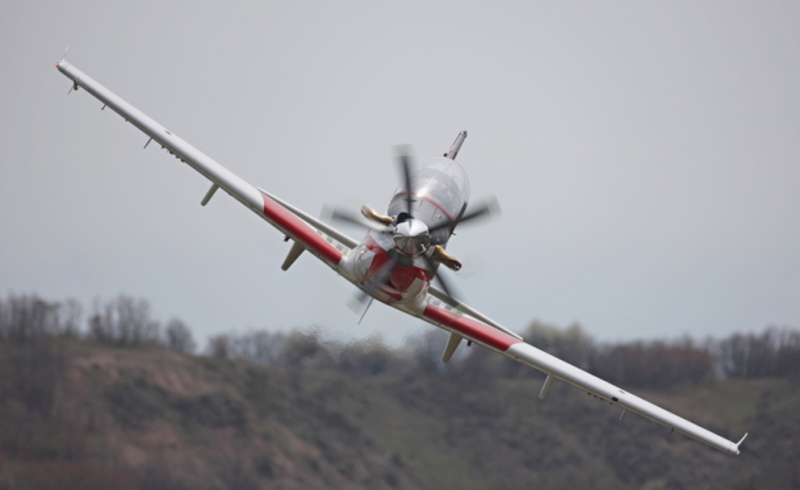
India has also developed a tandem-seat turboprop trainer, the Hindustan Aerospace LTD (HAL) "Hindustan Turbo Trainer (HTT) 40", very much along the lines of the Tucano. Initial flight of the first prototype of the HTT-40 was on 31 May 2016, a second prototype following a year later. Development has proven troublesome but it was finally certified in 2022, with the Indian Air Force ordering 70 in 2023.
In another footnote to the Tucano story, a firm named Calidus LLC of the United Arab Emirates has promoted a counter-insurgency aircraft, the "B-250", with a strong resemblance to the Tucano series. The resemblance was due to the fact that it was designed by one Joseph Kovacs, who was involved with Tucano development. The Brazilian company Novaer originally worked on the design, which was then known as the "Bader", with help from Rockwell Collins; Novaer was bought out by Calidus in 2015. The B-250 was unveiled to the world at the 2017 Dubai Air Show.
As it emerged, the general configuration of the B-250 was very much the same as that of the Tucano, though the B-250 featured considerable use of composite materials, making it about a tonne lighter. It was powered by a PWC PT6A-68 turboprop engine, providing 1,195 kW (1,600 HP), driving a four-blade Hartzell propeller. There were three stores hardpoints under each wing and under the centerline, for a total of seven. Total external stores load was 1,800 kilograms (3,960 pounds).
The B-250 featured a Rockwell Collins Pro Line Fusion avionics suite, sporting two large color multifunction displays, along with head-up displays. There was an electro-optic / infrared imaging turret under the nose. The cockpit was pressurized, with both crew sitting on Martin-Baker Mark 16 ejection seat. Development has also been protracted, with the B-250 yet to enter service, though Calidus is still promoting it.
BACK_TO_TOP* Having written up the Pilatus turbo-trainer series, it seemed only sensible to add the Tucano series as well. Besides, my site has some Brazilian readers, and it was nice to do something to make them happy.
* Sources include:
Several editions of JANE'S ALL THE WORLD'S AIRCRAFT were consulted as well.
* Illustrations details:
* Revision history:
v1.0.0 / 01 sep 08 v1.0.1 / 01 may 10 / Review & polish. v1.0.2 / 01 apr 12 / Review & polish. v1.0.3 / 01 mar 14 / Super Tucano purchases, TAI Huerkus details. v1.0.4 / 01 feb 16 / PZL Orlik MPT. v1.0.5 / 01 jan 18 / Review, update, & polish. v1.0.6 / 01 dec 19 / Review, update, & polish. v1.0.7 / 01 oct 21 / Review & polish. v1.0.8 / 01 sep 21 / Review & polish. (*)BACK_TO_TOP
